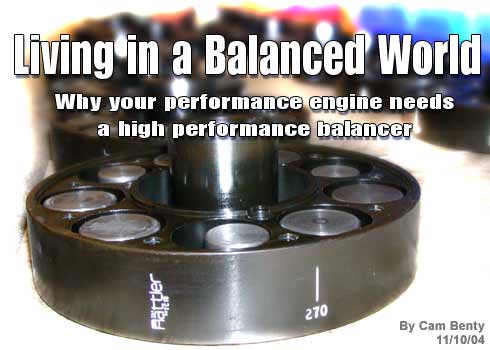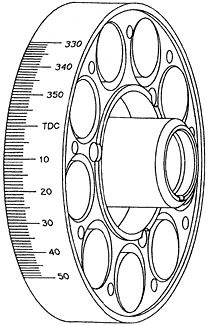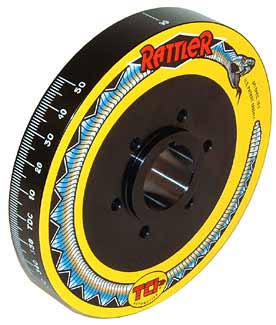|

As the Dalai Lama will tell you, balance is
one of the keys to achieving greater consciousness. For drag
racers, consciously building a balanced engine is the key
to greater performance. . . or so the Dalai Lama of high
performance will tell you.
But unbelievable as it may seem, there are still a number
of successful drag racers who believe that a stock original
equipment harmonic damper will work perfectly fine with your
drag racing engine. Wrong. The fact is that using an original
equipment damper is not only a mistake, but dangerous, and
could be stealing horsepower potential from your engine.
Here’s why.
Vibration can be controlled either by dissipating the energy
that causes the crankshaft to twist or by absorbing that
energy. A stock damper is tuned to the natural vibration
frequency of a stock engine. As soon as you change the internal
dynamics of an engine, such as by adding a performance crankshaft
or changing the pistons and valvetrain parts, you change
the frequency. To return to optimum performance you need
to re-tune your damper to your performance engine. Stock
cast iron elastomer dampers just can’t handle that
task and reduce your performance potential.
 High performance, SFI-approved devices like the TCI Rattler
are actually tuned to the number of engine cylinders and
engine cycles, which means that maximum effectiveness is
ensured regardless of engine modifications. Energy absorption,
common only to the Rattler, provides torsional control by
providing counteracting forces to those that actually cause
torsional vibration. Devices like the TCI Rattler actually
absorb the crankshaft-damaging twisting forces through the
movement of weighted “pucks” that store and release
energy as the crankshaft accelerates and decelerates. High performance, SFI-approved devices like the TCI Rattler
are actually tuned to the number of engine cylinders and
engine cycles, which means that maximum effectiveness is
ensured regardless of engine modifications. Energy absorption,
common only to the Rattler, provides torsional control by
providing counteracting forces to those that actually cause
torsional vibration. Devices like the TCI Rattler actually
absorb the crankshaft-damaging twisting forces through the
movement of weighted “pucks” that store and release
energy as the crankshaft accelerates and decelerates.
Other types of dampers, such as high performance elastomer,
dry friction and viscous-type dampers, work like OE dampers
by dissipating the vibrations by converting mechanical energy
to heat energy through friction. While this kind of damper
is a better choice than the stock unit, heat is always the
enemy of any engine part and in this case results in degradation
of the working mechanism over time.
“Stock cast iron OE elastomer dampers are not made
for high rpm situations,” says Stanley Poff of TCI. “Cast
iron dampers can crack and break with age ultimately exploding.
In addition, that elastomer system often 'slips' and can
even move far enough to release the outer ring making for
a very dangerous situation. True high performance balancers
are made from forged or billet steel and cannot come apart.”
 Eliminating torsional vibration improves the acceleration
rate of the engine. This means that through high tech engine
vibration analysis, engine rpm cycles are smoother and crankshaft
and bearing life increases which results in more efficient
valvetrain operation. The cost-saving rationale many racers
use to justify avoiding the expense of purchasing a high
performance balancer just doesn’t work when you think
about the added costs incurred when valve train parts and
bearings are damaged. Eliminating torsional vibration improves the acceleration
rate of the engine. This means that through high tech engine
vibration analysis, engine rpm cycles are smoother and crankshaft
and bearing life increases which results in more efficient
valvetrain operation. The cost-saving rationale many racers
use to justify avoiding the expense of purchasing a high
performance balancer just doesn’t work when you think
about the added costs incurred when valve train parts and
bearings are damaged.
“The part that really amazes me,” says Greg
Friend of TCI, “is that guys don’t realize that
the factory elastomer damper can wear out. Often the outer
ring of the damper has slipped over time. Unfortunately the
timing marks for the engine are on this ring. When the racer
goes to time the engine, they are not using accurate marks.
If your engine performance is lacking and you can’t
seem to find the problem and you are running a stock damper,
you might just want to check the damper!”
A high performance balancer is a required racing part,
as key to high performance as having the right set of rocker
arms or making certain the firing order is correct. A stock
OE damper may have been just fine in your street machine,
but for the serious racer, that balancer represents not only
a safety problem, but can also cost you engine life and optimum
performance.
|

